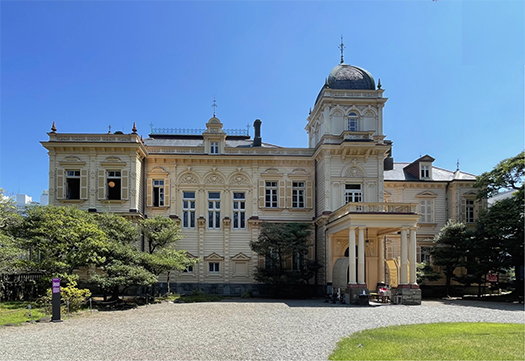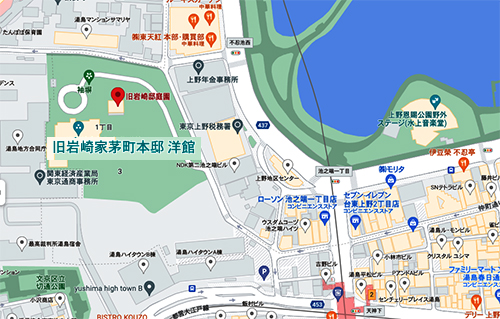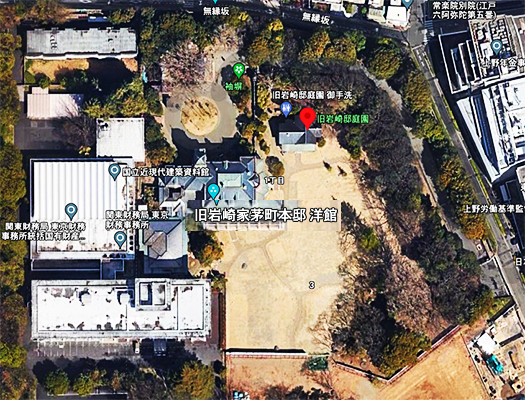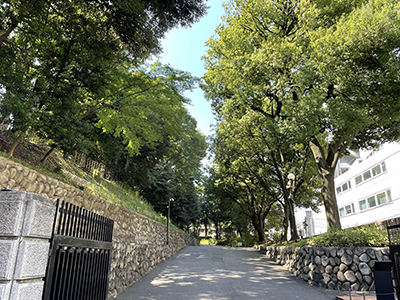
本日から東京上野にある「旧岩崎邸」探訪記をシリーズで始めたいと思います。弊社では関東地域での「関東の工務店と建てる」別冊企画を無事出版しましたが、それをきっかけとして、住宅の最大消費地・関東について俯瞰的な視点で地域性のようなものを捉えてみたいという願望からであります。
あまりにテーマが大きすぎてとても敵わないだろうとは承知していますが、利根川東遷、東国三社というように関東地域探究を重ねてみて、巨視的な掘り下げに挑戦はしてみたいと思ったのです。住宅の地域的文化性、時代的文化性など多様な視点があるので、地獄の釜を覗くような心境であります(笑)。でもまぁ、別に誰に迷惑にもならないだろうから、個人的に深掘りしたいのであります。
また一方、現在の状況は世界史的に非常にセンシティブな状況でもあると思います。隣国・中国の状況は非常に難局に至っていると考えられる。そういう状況を見るに付け、日本では資本主義、民間資本というものが経済の主人公であり、隣国では現在に至るもそうではないことがいちばん大きなテーマと思われるのです。
しかし、日本もつい150年前当時はそういった経済社会の揺籃期であった。それまでの武家による「専制」政治経済体制がさまざまな矛盾の爆発によって危機に至り、欧米の開かれた資本主義による開国要求と調和するように体制転換していった。そういう歴史経緯を経験してきている。
その時期に、いわば「政治と経済」の主体の独自発展・分化が進展した。経済は民間が主導し政治は制度の設計に専念するような近代国家志向が形成されていった。
住宅文化遺産としてはこの旧岩崎邸というのは、こういったテーマにとって象徴的な存在と思えるのですね。そんなテーマ意識ではじめて訪問させていただいた次第。


旧岩崎邸は、東京上野公園・不忍池にほど近い場所に立地している。こちらの敷地に隣接して「国立近代建築資料館」という施設があり、そちらで建築家住宅展が開催されていて、道に迷った結果、研究員の方から、この旧岩崎邸に直接ご案内いただいた、というのが訪問のきっかけでした(笑)。
研究員の方から伺ったのですが、旧岩崎邸敷地は徐々に国の施設が浸食してきているとのこと。都心に残る広大な土地ということでそのような経過状況なのでしょうね。ご案内いただいてようやくいちばん上の外観ポイントに立つことができました。

でもこの正面からいったん受付のある坂下までおりていく必要があった(笑)。裏口入園みたいな入り方だったので、入園料をお支払いするのに窓口に行き、そして戻って来たのであります(汗)。
ということで明日から、日本の資本主義が明治開国から創始していった様子を岩崎弥太郎(三菱の創業者)の邸宅をモデルに内観・外観などの写真と共に探訪したいと思います。
English version⬇
The Pioneering of Japanese Capitalism: Exploring the Former Iwasaki Residence-1
Ryoma Sakamoto and other samurai were keenly aware of the “separation of politics and economics” during the Meiji Restoration. This report includes the historical background of the residence of Mitsubishi founder Yataro Iwasaki, a native of Tosa. …
Today, we would like to start a series of articles on the “Former Iwasaki Residence” in Ueno, Tokyo. We have successfully published a separate volume of the “Building with Kanto’s Construction Companies” project in the Kanto region, and this is the beginning of our desire to take a bird’s eye view of the Kanto region, the largest consumer of housing in Japan, to see what the regional characteristics are.
Although I am aware that the theme is too large to be competitive, I would like to try to explore the Kanto region from the perspective of the Tone River eastward transition and the three shrines in the eastern part of the country, and to try to delve into the region from a macroscopic viewpoint. I have a diverse range of perspectives on the regional and historical culture of housing, so I feel as if I were peering into a cauldron of hell (laughs). But, well, I would like to dig deeper personally, because I am sure it will not bother anyone.
On the other hand, I think the current situation is very sensitive from a global historical perspective. The situation in China, our neighbor, is considered to have reached a very difficult point. The most important theme of this situation is that in Japan, capitalism and private capital are the protagonists of the economy, while this is not the case in the neighboring countries to this day.
However, Japan was in the infancy of such an economic society just 150 years ago. The previous “tyrannical” political and economic system of the samurai class had reached a crisis point due to an explosion of various contradictions, and the system was transformed to harmonize with the open capitalist demands of Europe and the United States. This is the historical background of the past.
It was during this period that the independent development and differentiation of the “political and economic” actors progressed. The economy was led by the private sector, and politics was devoted to the design of the system.
As a residential cultural heritage site, the former Iwasaki Residence seems to be symbolic of these themes. It was with this thematic awareness that I visited the house for the first time.
The former Iwasaki Residence is located near Shinobazu Pond in Tokyo’s Ueno Park. Adjacent to this site is a facility called the National Museum of Modern Architecture, where an exhibition of architects’ houses was being held, and as a result of getting lost, I was guided directly to this former Iwasaki residence by a researcher, which was the reason for my visit (laugh).
The researcher told us that the former Iwasaki residence site is gradually being encroached upon by government facilities. I guess such a situation is inevitable for such a large area of land remaining in the heart of the city. We were finally able to stand at the top of the exterior of the building.
But we had to go down to the bottom of the hill where the reception desk was located once from this front entrance (laugh). (Laughs). It was like entering the park through the back entrance, so I had to go to the counter to pay the entrance fee, and then came back (sweat).
So, starting tomorrow, I would like to explore how Japanese capitalism was founded from the opening of the country to the Meiji era, using the residence of Yataro Iwasaki (founder of Mitsubishi) as a model, along with photos of the interior and exterior of the house.
Posted on 9月 3rd, 2023 by 三木 奎吾
Filed under: 住宅取材&ウラ話







コメントを投稿
「※誹謗中傷や、悪意のある書き込み、営利目的などのコメントを防ぐために、投稿された全てのコメントは一時的に保留されますのでご了承ください。」
You must be logged in to post a comment.